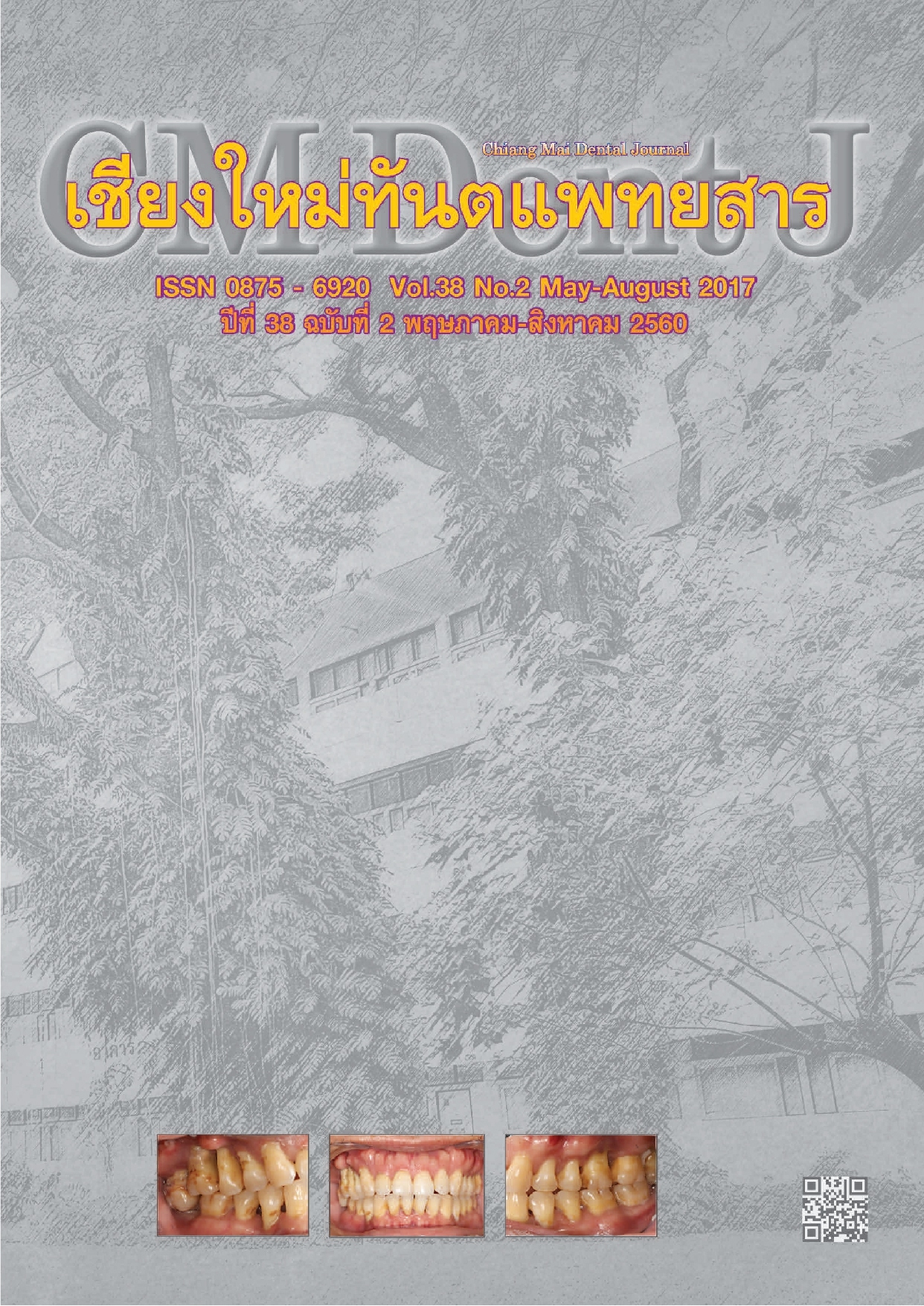The Effect of Different Phosphoric Acid-etching Times on Microtensile Bond Strength of Sealant on Different Enamel Substrates
Main Article Content
Abstract
Objective: The purpose of this study was to determine the effect of different phosphoric acid-etching times on microtensile bond strength (μTBS) of sealant on different enamel substrates. Materials and Methods: Extracted human molars were ground to create a flat surface of enamel. All the samples were randomly divided into 7 groups according to enamel substrates (CS: sound enamel, CD: artificial initial caries-like enamel, and CR: remineralized artificial initial caries -like enamel with 5% fluoride varnish) and etching times (10: Etching time 10 sec, 15: Etching time 15 sec, 25: Etching time 25 sec). Enamel blocks were bonded with Concise™ and trimmed to be an hourglass shape. The μTBS test was performed and the failure modes were assessed by SEM.
Results: The μTBS value of CD25 was statistically significantly lower (p<0.05) when compared to the CD10 and CD15. There were no significant differences among CR10, CR15, and
CR25. The μTBS value obtained from CD25 had a significantly lower bond strength compared to the control (CS15). The samples of CS15, CD15, and CD25 presented 4 types of failures. The cohesive failures within enamel were not found in CD10, CR10, CR15, and CR25. The conditioned artificial caries with of without fluoride varnish application for 25 sec exhibits a large porosity.
Conclusion: The use of sealant can performed on both initial enamel caries and remineralized enamel. In order to create better bond strength, the initial enamel caries should be etched for no more than 15 sec. In contrast, the increasing of etching time up to 25 sec is not influenced to the bond strength of sealant on the remineralized enamel. These results may be applied on the sealant application in clinical procedure.
Article Details
References
Feigal RJ. The use of pit and fissure sealants. Pediatr Dent 2002; 24: 415-422.
Wang J-D, Chen X, Frencken J, Du M-Q, Chen Z. Dental caries and first permanent molar pit and fissure morphology in 7- to 8-year-old children in Wuhan, China. Int J Oral Sci 2012; 4(3): 157-160.
Ole Fejerskov, Edwina A M Kidd. Dental caries: the disease and its clinical management 2nd ed. Oxford; 2008.
Feigal RJ. Sealants and preventive restorations: review of effectiveness and clinical changes for improvement. Pediatr Dent 1998; 20(2): 85-92.
Weintraub JA. The effectiveness of pit and fissure sealants. J Public Health Dent 1989; 49(5 Spec No): 317-330.
Welbury R., Raadal M, Lygidakis N. A. EAPD guidelines for the use of pit and fissure sealants. Eur J Paediatr Dent 2004; 5(3): 179-184.
Silverstone LM, Saxton CA, Dogon IL, Fejerskov O. (1975). Variation in the pattern of acid etching of human dental enamel examined by scanning electron microscopy. Caries Res 1975; 9(5): 373-387.
Barkmeier WW, Shaffer SE, Gwinnett AJ. Effects of 15 vs 60 second enamel acid conditioning on adhesion and morphology. Oper Dent 1986; 11: 111-116.
Hobson RS, McCabe JF. Relationship between enamel etch characteristics and resin-enamel bond strength. Br Dent J 2002; 27; 192(8): 463-468.
Triolo PT, Swift Jr EJ, Mudgil A, et al. Effects of etching time on enamel bond strengths. Am J Dent 1993; 6: 302-304.
Guba CJ, Cochran MA, Swartz ML: The effects of varied etching time and etching solution viscosity on bond strength and enamel morphology. Oper Dent 1994; 19: 146-153.
Hashimoto M, Ohno H, Kaga M, Sano H, Tay FR, Oguchi H, Kubota M. Over-etching effects on micro-tensile bond strength and failure patterns for two dentin bonding systems. J Dent 2002; 30(2-3): 99-105.
Kantovitz KR, Pascon FM, Alves MC., Nociti FH, Tabchoury CP, Puppin-Rontani RM. Influence of different enamel substrates on microtensile bond strength of sealants after cariogenic challenge. J Adhes Dent 2011; 13(2): 131-137.
Silverstone LM, Saxton CA, Dogon IL, Fejerskov O. Variation in the pattern of acid etching of human dental enamel examined by scanning electron microscopy. Caries Res 1975; 9(5): 373-387.
Celiberti P, Lussi A. Penetration ability and microleakage of a fissure sealant applied on artificial and natural enamel fissure caries. J Dent 2007; 35(1): 59-67.
El-Housseiny AA, Sharaf AA. Evaluation of fissure sealant applied to topical fluoride treated teeth. J Clin Pediatr Dent 2005; 29(3): 215-219.
Brannstrom M, Nordenvall KJ, Malmgran O. The effect of various pretreatment methods on the enamel in bonding procedures. Am J Orthod 1955; 74: 522-530.
Koh SH CJ, You C. Effects of topical fluoride treatment on tensile bond strength of pit and fissure sealants. Gen Dent 1998; 46(3): 278-280.
Warren DP, Infante NB, Rice HC, Turner SD, Chan JT. Effect of topical fluoride on retention of pit and fissure sealants. J Dent Hygiene 2001; 75: 21-24
Thornton JB, Retief DH, Bradley EL Jr, Denys FR. The effect of fluoride in phosphoric acid on enamel fluoride uptake and the tensile bond strength of an orthodontic bonding resin. Am J Orthod Dentofacial Orthop 1986; 90(2): 91-101.
Garcia-Godoy F. Shear bond strength of a resin composite to enamel treated with an APF gel. Pediatr Dent 1993; 15: 272-274.
Pipatphatsakorn M. Microtensile bond strength of new self-adhesive flowable resin composite on different enamel substrates. CU Dent J 2015; 38(Suppl): 83-96.
Bryant S, Retief DH, Bradley EL Jr, Denys FR. The effect of topical fluoride treatment on enamel fluoride uptake and the tensile bond strength of an orthodontic bonding resin. Am J Orthod 1985; 87(4): 294-30
Kimura T, Dunn WJ, Taloumis LJ. Effect of fluoride varnish on the in vitro bond strength of orthodontic brackets using a self-etching primer system. Am J Orthod Dentofacial Orthop 2004; 125(3): 351-356.
Low T, Von Fraunhofer JA, Winter GB. The bonding of a polymeric fissure sealant to topical fluoride-treated teeth. J Oral Rehabil 1975; 2(3): 303-307.
Tandon S, Kumari R, Udupa S. The effect of etchtime on the bond strength of a sealant and on the etch-pattern in primary and permanent enamel: an evaluation. ASDC J Dent Child 1989; 56(3): 186-190.
Tandon S, Mathew TA. Effect of acid-etching on fluoride-treated caries-like lesions of enamel: a SEM study. ASDC J Dent Child 1997; 64(5): 344-348


